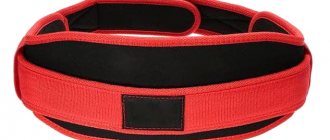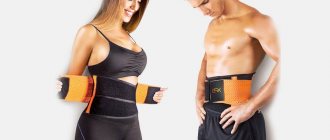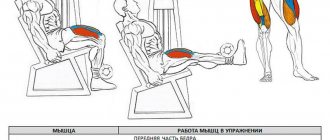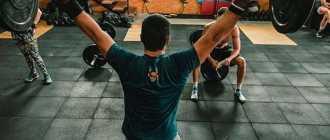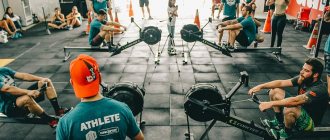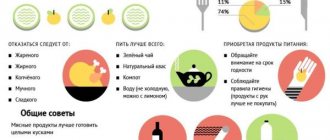- January 26, 2019
- Workouts in the gym
- Kira Ifeevskaya
In our article we will talk about what a weightlifting belt is and how to choose it. Perhaps not everyone understands why athletes need this accessory. Note that it is most often used by weightlifters, powerlifters and bodybuilders in their weight training exercises. Let's try to understand this topic in detail. We will look further at the types of belts and give advice on choosing.
Description of the accessory and its functional features
In strength training, there are exercises with a barbell. When they are performed, a lot of pressure is created on the lower back and spine of a person. As a result, unpleasant sensations appear. To reduce the likelihood of injury, wear a special weightlifting belt; we’ll tell you how to choose it below. It is usually pulled tight at the waist. There is also a negative consequence to this. This is an increase in intra-abdominal pressure, so using the product for a long time is not recommended. When used during training, the lumbar discs and the spine itself are fixed. This helps avoid back injuries.
When is a weightlifting belt necessary?
- Athletes striving for results in a short time do not have time to strengthen the muscles of the back and abdomen to reliably support the spinal column. Increasing the weight without a belt will lead to injury.
- Exercises with lifting weights - squats with a barbell, deadlifts.
- Exercises with a weight of 80-90% of the mass that the athlete lifts.
Please rate the article:
( 3 ratings, average: 5.00 out of 5)
Save or share with friends:
Main types of training products
To understand how to choose a weightlifting belt, you should familiarize yourself with the types of such an accessory. There are two types:
- Powerlifting belt. The name speaks for itself. The accessory is intended for representatives of this sport. Ideal for workouts that primarily involve exercises performed with a straight back. The accessory is the same throughout its entire length and width. Usually it is 10 centimeters. It is necessary to ensure that the belt fits tightly, positioning it as close as possible to the pelvic bones. If we compare this type of accessory with the next one, we can safely say that this one is distinguished by its great thickness, strength and massiveness.
- Weightlifting belt. Its distinctive features are flexibility and a significant level of comfort when performing exercises with body bends. Another difference is the variable width of the product around the entire circumference. The narrow part falls on the stomach, and the wide part is located on the lower back. Due to the characteristics of the belt, it is very often used by bodybuilders.
Sports belts with Velcro
1
Belt Green hill WLB-6732A
910 RUR
Rating 4.7
Belt for athletes involved in strength sports. This belt with a flexible fastener is suitable for beginner athletes who are just developing their technique and learning the exercises. It is quite cheap and made of dense material, fixing the back quite rigidly. This category of belts has one main disadvantage - Velcro is not very reliable during long-term use. Over time, you will have to replace the belt with a new one, this is more than compensated for by its low price. The soft fabric will not rub your skin, making it very comfortable to practice in.
Purpose weightlifting Fastening type Velcro closure Material neoprene
4.7 / 5 rating
2
Belt TORRES PRL619017
RUB 1,040
Rating 4.2
1 reviews
The athletic belt has Velcro, with a special perforation on the back pad, which promotes air circulation and reduces sweating. It also allows the skin at the contact site to breathe freely, which reduces the likelihood of skin irritation. The manufacturer tried to make the clamp as high quality as possible to extend the service life of the accessory. It is very popular among women for their fitness activities with light weights. This is a great option.
Purpose weightlifting Fastening type Velcro fastening Main width 110 mm Rear width 200 mm Softening lining available Material neoprene, polyester Additional information internal lining made of neoprene 3 mm thick
4.2 / 5 rating
3
Belt Harper Gym JE-2627
750 RUR
Rating 4.1
10 reviews
A narrow Velcro belt, usually used as a general belt in gyms. It is great for helping beginners avoid injury by fixing their spine in the correct position. Made of soft and durable synthetic material, which allows air to pass through easily and prevents the skin from sweating during exercise. For serious weights, we recommend that you take a closer look at more serious models.
Purpose weightlifting Fastening type Velcro fastening Main width 152 mm Material neoprene Additional information S: length 90 cm, waist circumference 76-86 cm; M: length 100cm, waist 86-100cm; L: length 110cm, waist 94-104cm; XL: length 115 cm, waist 100-117 cm
Main advantages:
Price
Minuses:
Completely inconsistent with the description! I ordered size L (in the description UNTIL IT WAS REMOVED :)) it was written 80-90 cm, when fully tightened I got 98!!!! And of course I ordered a size smaller, received it, used it once when unloading the goods, normal. Unfortunately the belt was lost in a fire(
4.1 / 5 rating
Reviews
Couldn't rate it due to size mismatch. Was able to evaluate a normal belt on the second try(
Read more
Athletic belt sizes
First, I would like to note that before purchasing, it is very advisable to put the item on yourself, so as not to make a mistake in the size. But, unfortunately, this does not always work out. For example, if you plan to purchase from an online store.
To choose a weightlifting belt, you should first measure your waist circumference. This figure will help you choose the right accessory.
If you plan to buy an item not in an online store, but in a real boutique, then when trying on an item, be sure to pay attention to how the item fastens on you. Remember that the ideal size is when the belt is attached to the middle holes. In the selection process, we should also not forget that an athlete’s parameters such as weight and volume may change throughout the year. Therefore, you should always leave a couple of holes in reserve on the belt so that you can loosen or tighten it.
Many sports equipment stores have their own sizing charts. Therefore, it is worth checking this information with a consultant here. But you can use the standard parameters. These will help you determine the most appropriate weightlifting belt size:
- with a waist size of 62-80 cm, you need to take S;
- if your waist is more than 72 cm, but less than 90 cm, then M will suit you;
- for L, the waist should be 82-90 cm;
- waist size on XL - 92-110 cm
- on XXL - 102-120 cm.
Comparative table of product characteristics from the rating
| Name | Belt Green hill WLB-6732A | Belt TORRES PRL619017 | Belt Harper Gym JE-2627 | Belt Onhillsport PS-0515 | Belt TORRES PRL619018 | Belt Harper Gym JE-2623 | Belt Onhillsport PS-0566 |
| Category | Sports belts with Velcro | Sports belts with belt fastener | Sports belts with fastener | ||||
| Place | 1 | 2 | 3 | 1 | 2 | 3 | 1 |
| Purpose | Weightlifting | Weightlifting | Weightlifting | powerlifting | Weightlifting | Weightlifting | powerlifting |
| Mounting type | Velcro fastener | Velcro fastener | Velcro fastener | double clasp | double clasp | double clasp | carbine |
| Material | neoprene | neoprene, polyester | neoprene | leather | leather | leather | leather |
| Main width | 110 mm | 152 mm | 100 mm | 60 mm | 102 mm | 100 mm | — |
| Rear Width | 200 mm | 150 mm | — | — | — | — | — |
| Softening lining | There is | — | — | — | — | — | — |
| Additional Information | 3mm neoprene inner lining | S: length 90cm, waist 76-86cm; M: length 100cm, waist 86-100cm; L: length 110cm, waist 94-104cm; XL: length 115 cm, waist 100-117 cm | Soft suede interior and extra padding on the back | S: length 95cm, waist 68-88cm; M: length 105cm, waist 77-97cm; L: length 110cm, waist 83-103cm; XL: length 115 cm, waist 88-108 cm | — | — | — |
| Layering | 2 layers | 2 layers | — | — | — | — | — |
| Thickness | 6 mm | 6 mm | — | — | — | — | — |
| Skin type | natural | natural | natural | natural | — | — | — |
What material is used to make the belt?
Those who are thinking about how to choose a weightlifting belt should know what materials this accessory is made from.
Typically, these products are made from leather, its substitutes, and synthetic materials. Of course, the undoubted leader is genuine leather. It is popular because it has high wear resistance and tensile strength, unlike other materials. But this is precisely why it is quite expensive. However, if you engage in moderate physical activity, you can use belts made of synthetic materials with Velcro.
Sports belts with fastener
1
Belt Onhillsport PS-0566
RUR 3,900
Rating 4.8
2 reviews
Unfortunately, he will get first place automatically. There are no more competitors in its category in our market. This is a professional belt. It meets all federation standards and is made to last. Multiple layers hold your spine very tightly at the most dangerous points when performing the movement. The front lock deserves special attention. It snaps securely and will not fall off at the most crucial moment. Fully leather made from natural material. With such an accessory, you can safely take first place and achieve high results.
Purpose powerlifting Fastening type carabiner Ply 2 layers Thickness 6 mm Main width 100 mm Material leather Type of leather natural
4.8 / 5 rating
Rate this article
Total votes - 0, rating - 0
Popular vote - Choose the safest training belt from the list?
- Vote
- results
Types of fasteners for sports accessories
To choose a weightlifting belt, you also need to pay attention to the clasp. There are three types:
- Classic buckle. It is actively used when sewing belts. The ideal option is the classic one with two teeth.
- Velcro. Can be used by those who train with light weights.
- Lobster buckle. Quite a popular clasp. True, athletes have conflicting opinions about it. Some talk about its convenience and reliability, while others express their distrust.
Wearing rules
Constantly wearing a belt weakens your own muscles. The press loses tone, and the risk of injury increases with light loads. A weightlifting belt is not suitable for training with light weights. If your body is accustomed to the weightlifting belt, choose a gradual weaning pattern. The goal is to strengthen the back and abdominal muscles, reducing the time of wearing the belt to a minimum.
Exercising without a belt causes the abdominal muscles to tense and retract. When using additional sports equipment, the muscles “stick out” the stomach. When returning to natural technique, athletes have to relearn.
- Wear the belt when performing weight-bearing exercises in a standing position while holding the weight overhead.
- Pay attention to working out your abs.
- As you get used to the weight, reduce the number of approaches using the belt.
Other characteristics
Note that multi-layer belts made of genuine leather, stitched with a zigzag pattern, are absolutely wear-resistant and flexible. Thanks to this, the accessory can easily be adjusted to the characteristics of each figure.
I would also like to advise those who are thinking about how to choose a weightlifting belt to pay attention to the quality of the holes. The latter should be framed with eyelets.
If you plan to purchase an accessory that is not made of leather, then be picky when choosing a product. It must be carefully executed and have a trademark. When buying a cheap Chinese product, you need to be prepared for the fact that it will not last long.
Material
Leather is the strongest and most durable material. Cons: high cost, unsuitable for athletes with problem skin (causes irritation during training). A leather belt is optimal for athletes who lift heavy weights.
Faux leather, nylon, neoprene, polyester are lightweight and elastic materials that will cost less than natural leather. A product made from such materials does not hinder movement. The disadvantage is relatively low wear resistance. This belt is chosen by athletes working with light and medium weights.
Types of belts
This is the basis of any product, regardless of purpose. In this case, it is the configurations of the belt shape that are considered, which can be different. The classic design is characterized by the aforementioned widening at the back and the presence of a narrow area in front. This ratio allows you to conveniently perform inclined movements. There are also special wide belts. They reach 15 cm, covering the functional lumbar part. But this option will not be acceptable for every weightlifting activity. Despite the tight fit to the lower back, such a belt leaves the back arches open, which in some sports is a critical violation of safety regulations.
Facts about the belt
Please note that the athletic belt itself does not protect your back, but creates better conditions for the body’s natural defenses to work. That is, this is not additional protection, but an amplifier of existing protection. For this reason, it is contraindicated for beginners to use the belt. As mentioned above, your natural belt can handle quite a lot of loads, so the first step is to get into shape what you already have. Slowly, without haste, your body adapts to the stress. Along the way, you will study your body in detail, learn to listen to it, understand it and more accurately control it. This is a kind of foundation, without which going anywhere further is not only pointless, but also extremely dangerous to health.
What else is taken into account in a weightlifter’s equipment?
In addition to the belt, special shoes (barbells), bandages, overalls and plasters are also selected. The knees, wrists, hands and other areas of the body that are actively involved in the direct supply of force should be protected and strengthened. Particular attention is paid to shoes that insure the feet, also giving them stability while holding the mass on the platform. Special reinforcement is provided in the rear area of the boot, covering the heel. Like a weightlifting belt, these pieces of equipment can be made from different materials. But in addition to strength qualities and functionality, one should not forget about the environmental friendliness of the products. This is especially true for those accessories that are in direct contact with the body.
Purchase
The best manufacturing companies
Athletic belts are produced by many companies. Here is a list of the most famous: Adidas, Vamp, Grizzly, Mad Max, Torneo, Ironman, Jet Sport, Schiek. These companies produce belts for both professionals and amateurs. The quality of the belt is directly dependent on its price. It is worth understanding that when buying a cheap athletic belt, it may soon become unusable.
Prices
A good athletic belt won't come cheap. But if you are a beginner or don’t want to lift heavy weights, then you can look at budget options. A Torneo belt made of synthetic material will cost you about 700 rubles. A belt made of genuine Grizzly leather will cost 2000-2500 rubles. The cost of a professional athletic belt starts from 2500-3500 rubles.
What to remember when buying an athletic belt
- A belt made of genuine leather will cost much more than its artificial counterparts. Don't buy the cheapest belt. It may not last long. As a result, you will have to spend money on purchasing a new belt.
- If you do not have the opportunity to purchase a belt made of genuine leather, then a belt made of a combined material will do. It is made from natural and synthetic materials.
- Faux leather belts may attract you with their affordable price, but they don't last long.
In what cases is it not needed?
When an athlete wears a belt, intra-abdominal pressure increases. Thanks to this, the spine and intervertebral discs are fixed in one position. Your abdominal muscles tighten during the approach, and you press your stomach into your waistband—this helps keep your spine straight.
Your lower back stabilizing muscles become weaker. Regular wearing of an athletic belt during training leads to this.
Read also: How to do a glute bridge correctly
Moreover, if you decide to take the weight without a belt a little less than usual, then there is a high probability of getting a back injury. When training without a belt, the abdominal muscles must be contracted and pulled towards the back, and not protruded as when training with a belt. It is necessary to combine training with large weights with a belt and small ones without a belt.
If you exercise for your own pleasure and the beauty of your body, then a belt can bring you a lot of trouble. Attention should be paid to strengthening the abdominal and back muscles. The weight of the bar should increase gradually. Gain muscle growth.

